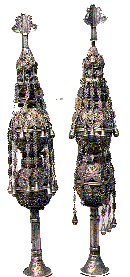Documenting the Material Legacy of the
According to legend, Jews have resided in Tunisia since the destruction of the First Temple in Jerusalem, in 586 BCE. While this cannot be substantiated by historical evidence, it is known that Tunisia was home to the most important center of Jewish life in North Africa during the period of the Roman Empire. In June 1997 an expedition from the Center for Jewish Art, set out to explore this rich legacy. The focal point of the survey and documentation expedition was the island of Djerba, which has the largest population of Jews in Tunisia today.
Center researchers were familiar with Tunisian ritual objects and synagogue design through their explorations of the North African communities in Israel. Researchers discovered many similarities between the Libyan and Tunisian communities, which is apparent in the similar shape, decoration and motifs of ritual objects. The beautiful wood painted Torah cases, six of which can be found in Israel, were a center piece of their discoveries in Djerba. Finding dozens of such Torah cases was indeed a surprise and assisted researchers in identifying distinctive characteristics of each culture.
Various accounts are given of the origins of Jewish settlement in Djerba, the most ancient Jewish community in Tunisia. The popular version is that following the destruction of the First Temple in Jerusalem, a group of priests (Cohanim) found their way to Djerba. They carried with them one of the gates of the destroyed Temple, and set it in the foundation of the synagogue they built in Djerba called the Ghriba Synagogue (el Ghriba). Thus, they preserved the memory of the Temple within the very fabric of their own synagogue.
Interior of the Cohanim De'getiyah
Synagogue in the hara kebira in Djerba.
The most important and oldest synagogue in Djerba is the Ghriba, built by the Cohanim in the hara zrira. The Ghriba
The Ghriba Synagogue became an architectural model for almost all of the synagogues and yeshivot built in Djerba because of its importance as a holy place. Thus, the basic structure of all the synagogues is the same. They are composed of an inner courtyard surrounded by roofed loggias with columns and arches. The prayer halls, which one enters from the outer courtyard, are also surrounded by columns and arches. Though they are entirely enclosed, the halls are similar in construction to the courtyard. Above the central part of each synagogue hall is a square clerestory consisting of twelve windows, three on each wall, which provide light for the entire synagogue. The tradition of the twelve windows probably derives from the Kabbalistic Book of Zohar where it is said that all synagogues should be built with twelve windows representing the twelve tribes of Israel. Directly beneath the clerestory is a large tevah (reader's desk). One wall is made up of a series of separate Torah arks. The seating is along the periphery of the prayer hall and around the tevah. The yeshivot in the hara zrira were also built according to the design plan of the Ghriba Synagogue, but they do not have Torah arks.
Researchers documented eight of these synagogues in the hara kebira and surveyed nine yeshivot in the hara zrira. Unfortunately, they were unable to document the Ghriba Synagogue because the expedition took place during the peak tourist season and the synagogue was overflowing with visitors. They also documented approximately 250 ritual objects.
The wooden Torah cases documented in the hara kebira of Djerba have between eight and sixteen facets. Some are colorful and painted with floral and geometrical motifs (similar to those researchers were familiar with from collections in Israel), while others are decorated with stucco and painted with silver and gold. Still others are of plain wood. On the upper portion of the Torah cases are wooden coronets with facets in the shape of the cases. Two of the earliest Torah cases which researchers documented are from the eighteenth century. One is painted red and decorated with wreaths of flowers, and the other is plain wood decorated with metal nails.

19th century silver Torah finials from Djerba
Torah case wrappers, most of which are made from velvet fabric and embroidered with silver and gold threads, were found on many of the Torah cases in Djerba. Most wrappers were nailed directly to the case, while the plain wood Torah cases had special knobs affixed for hanging them. It is very likely that the old local tradition was to leave the decorated Torah cases uncovered, which explains why no knobs were found on the earlier ones. The use of Torah wrappers was probably adopted from the Libyan tradition.
Most pointers documented by our researchers in Djerba have the same shape: leaf-shaped with an elongated bar and an extended index finger. The pointers bear dedicatory inscriptions and are decorated with floral motifs.
Various types of Hanukkah lamps were documented, both wooden and metal with glass oil containers. Researchers documented several cast open-work copper lamps, composed of a horizontally divided back wall, and a lower section comprised of a horseshoe arcade topped by an arch. Eight oil containers with sprouts are attached to the back wall of the lamp.
No doubt that other expeditions to Djerba and to other cities in Tunisia will provide a fuller picture of the visual heritage of Tunisia and Djerba and will reveal the links between the Djerban community and those of Libya and Italy. Researchers concluded last year's expedition with a survey of Jewish art and architecture in the capital city of Tunis and the towns of Zarzis, Sfax and Gabes. If the political climate permits, Center researchers will return to Tunisia to complete documentation of its rich material heritage.
This expedition was made possible with the generous support of the Fanny and Leo Koerner Charitable Trust, Cambridge, Massachusetts, and the Rich Foundation, Tel Aviv.




